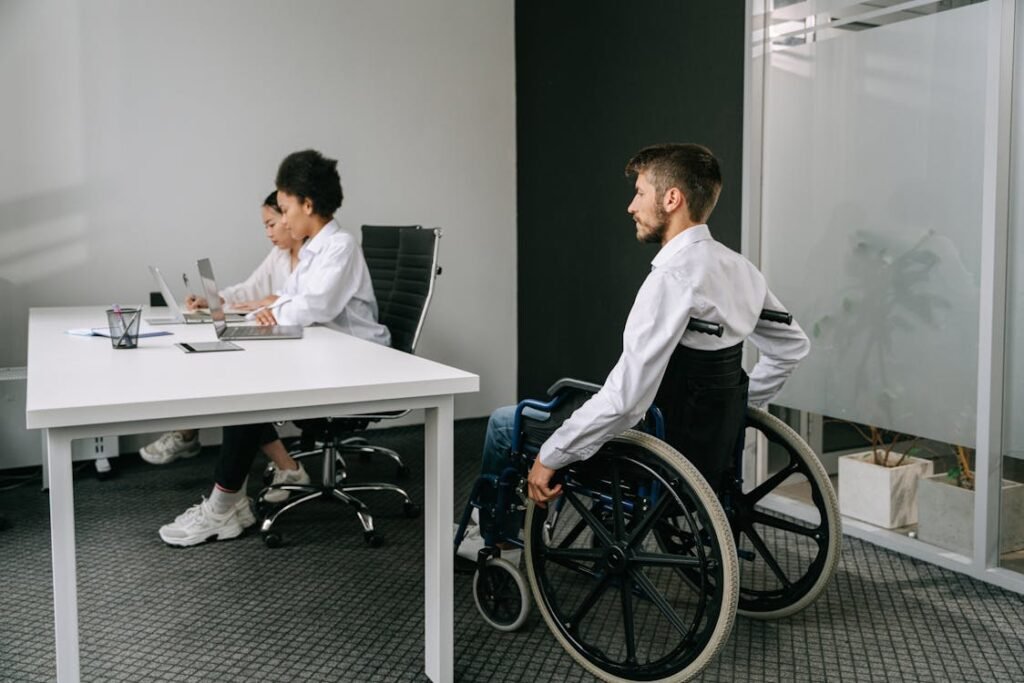Workplaces are meant to be spaces where all employees feel valued, comfortable, and able to perform at their best. However, for individuals who use prosthetics, the workplace can present unique challenges. From physical accessibility barriers to unconscious biases, employees with prosthetic limbs often encounter obstacles that their colleagues may not even notice.
A truly inclusive workplace goes beyond just hiring people with disabilities—it ensures they have the right support, tools, and environment to succeed. Simple adjustments in office design, company policies, and workplace culture can make a significant difference in making employees with prosthetics feel welcomed and empowered.

Understanding the Needs of Employees with Prosthetics
Creating an inclusive workplace begins with understanding the unique needs of employees who use prosthetic limbs. While prosthetics help individuals regain mobility and independence, they are not a perfect replacement for natural limbs.
Employees may experience discomfort, require adjustments, or need specific accommodations to perform their best at work.
Each individual’s experience with a prosthetic is different. Some may have no difficulty navigating their workspace, while others may need modifications to ensure they can move comfortably and work efficiently.
Recognizing that needs vary from person to person is the first step in fostering a truly inclusive environment.
Physical Comfort and Accessibility in the Workplace
One of the primary concerns for employees with prosthetics is physical accessibility. Workspaces should be designed with mobility in mind, ensuring that individuals with prosthetic limbs can navigate the environment without unnecessary strain.
Office layouts should have wide walkways and unobstructed pathways, allowing employees with prosthetic legs to move freely without worrying about tight spaces or obstacles.
Desks and workstations should be adjustable to accommodate employees who may need different seating arrangements to remain comfortable throughout the day.
For those who use prosthetic arms or hands, tasks like typing, using office equipment, or handling small objects may require slight modifications.
Providing ergonomic tools, such as adjustable keyboards or voice-activated software, can make everyday tasks easier and more efficient.
Rest areas should also be designed with inclusivity in mind. Employees with prosthetics may need to remove or adjust their prosthetic limbs during the day, especially if they experience discomfort after prolonged use.
Having private, comfortable spaces where they can rest without disruption fosters a workplace that prioritizes their well-being.
Workplace Policies that Support Employees with Prosthetics
Beyond physical accessibility, inclusive policies ensure that employees with prosthetic limbs are supported in every aspect of their professional journey.
One of the most important workplace policies is flexibility. Employees with prosthetics may require time for medical appointments, prosthetic adjustments, or physical therapy.
Offering flexible work hours or remote work options when needed can make a significant difference in their ability to maintain a healthy work-life balance.
Health and safety policies should also be updated to include considerations for employees with prosthetic limbs.
Emergency evacuation plans, for instance, must take into account employees who may require additional assistance in case of an emergency. Ensuring that all safety protocols are inclusive and accessible demonstrates a commitment to employee well-being.
Workplaces should also consider insurance and healthcare benefits that cover prosthetic maintenance and related medical needs.
Many employees with prosthetics require periodic adjustments or replacements for their devices, and offering healthcare benefits that support these needs helps reduce financial and logistical stress.
Reducing Bias and Fostering Workplace Inclusion
Even when physical accommodations and policies are in place, workplace culture plays a crucial role in making employees with prosthetics feel truly included. Unfortunately, unconscious bias and misconceptions about prosthetic users still exist in many professional environments.
Colleagues and managers may assume that employees with prosthetics are less capable of performing certain tasks or require constant assistance. In reality, most individuals with prosthetic limbs develop skills and strategies to perform their work just as effectively as their peers.
Workplace training programs that focus on disability inclusion and awareness can help reduce biases and misconceptions.
These sessions should educate employees about prosthetic technology, workplace accessibility, and respectful communication with colleagues who use prosthetics.
Encouraging open discussions and providing opportunities for employees to ask questions in a supportive setting can break down barriers and create a more inclusive culture.

Providing the Right Tools and Technology for Employees with Prosthetics
An inclusive workplace is one that ensures every employee has the right tools to succeed. For employees with prosthetic limbs, this means offering technology and equipment that allow them to perform their tasks comfortably and efficiently.
Simple modifications to office tools, digital systems, and workstations can make a significant difference in productivity and job satisfaction.
Ergonomic Workstations for Comfort and Efficiency
Employees with prosthetic arms or hands may find traditional office setups challenging when performing tasks that require fine motor skills, such as typing or handling small office equipment.
Adjustable workstations with ergonomic keyboards, trackball mice, or voice-recognition software can provide alternative ways to complete tasks without strain.
For those who use prosthetic legs, standing desks that can be lowered to a seated position allow for greater flexibility and comfort throughout the workday.
Seats and desk heights should also be adjustable to accommodate different mobility needs. Employees with lower limb prosthetics may prefer a seating arrangement that provides additional legroom or allows them to adjust their posture throughout the day.
Ensuring that these modifications are readily available rather than requiring employees to request them removes unnecessary barriers to workplace comfort.
Assistive Technology for Digital Accessibility
With the increasing use of digital tools in the workplace, ensuring that software and systems are accessible to employees with prosthetic limbs is crucial.
Some individuals may find it easier to use speech-to-text software for writing emails and documents, while others may benefit from customizable keyboard shortcuts to reduce repetitive hand movements.
Touchscreen devices with adjustable sensitivity settings can make navigation easier for employees who use prosthetic hands.
Companies should also ensure that all digital platforms, including internal software and communication tools, are compatible with assistive technologies.
Making these adjustments standard practice ensures that employees with prosthetics can work as efficiently as their colleagues.
Providing Onboarding and Training Support
When hiring employees with prosthetic limbs, companies should provide adequate onboarding and training that takes their needs into account.
Standard workplace training programs may not always address accessibility concerns, so offering individualized sessions can help employees learn how to navigate their new work environment comfortably.
Supervisors and HR teams should have open conversations with new hires to understand their specific needs and preferences. This ensures that accommodations are made proactively, rather than waiting for an employee to bring up concerns.
Offering mentorship programs where employees with prosthetics can connect with colleagues who have similar experiences can also foster a sense of community and support within the workplace.
Encouraging Collaboration and Teamwork
Inclusivity in the workplace is not just about policies and tools—it is also about how employees interact with one another. Colleagues should be encouraged to collaborate with employees with prosthetics without making assumptions about their capabilities.
Team leaders can foster this inclusive mindset by assigning projects based on skill and interest rather than perceived ability.
Employees with prosthetic limbs should be given equal opportunities for leadership roles, promotions, and team projects.
Ensuring that they are recognized for their contributions and potential helps break down stereotypes and creates a workplace culture where everyone is valued for their talents.

Building a Workplace Culture of Inclusion and Respect
While physical accommodations and technological support are essential, true workplace inclusion goes beyond adjustments to infrastructure and tools. A company’s culture determines how welcome and valued employees with prosthetics feel in their roles.
Fostering a respectful, understanding, and inclusive environment ensures that employees with prosthetics are not just accommodated, but fully integrated into the workplace.
Encouraging Open Conversations About Accessibility Needs
One of the most effective ways to create an inclusive environment is by normalizing discussions around accessibility. Employees with prosthetics should feel comfortable expressing their needs without fear of judgment or being seen as an inconvenience.
Managers and HR teams should take the initiative to check in regularly with employees, asking if their workspace or job duties need any modifications.
However, it’s important to approach these conversations in a way that respects the employee’s autonomy. Rather than assuming what they need, employers should ask open-ended questions like, “Is there anything we can do to support you in your role?” or “Would any adjustments make your workday more comfortable?”
Encouraging open dialogue also applies to colleagues. Many employees may hesitate to ask questions about prosthetics out of fear of saying the wrong thing.
While every individual has different comfort levels, creating an environment where respectful curiosity is welcomed can reduce misunderstandings and foster better teamwork.
Eliminating Workplace Stigma and Stereotypes
Despite advances in disability inclusion, outdated stereotypes about prosthetics and physical ability still exist. Some employees with prosthetic limbs may encounter biases that assume they are less capable, need constant assistance, or should be limited to specific job roles.
These assumptions create barriers that prevent employees from advancing in their careers or being taken seriously as professionals.
Workplace training programs that address unconscious bias can help eliminate these misconceptions. These programs should educate employees and leadership on how to interact with colleagues with prosthetics in a way that is respectful and empowering.
For example, assuming that an employee with a prosthetic leg cannot handle a physically active role without first discussing it with them can be exclusionary.
It is essential to recognize that many individuals with prosthetics are fully capable of performing the same tasks as their colleagues and should be treated accordingly.
Creating Inclusive Social and Professional Opportunities
Workplace inclusion is not just about job performance—it also extends to company culture and social interactions. Employees with prosthetics should feel just as involved in workplace activities, team-building events, and networking opportunities as their peers.
Employers should ensure that all workplace events are accessible. If an activity involves physical movement—such as a company sports event or an offsite retreat—employees with prosthetics should be given the option to participate in ways that suit their abilities.
Alternative options should be available to ensure that no one is left out simply because an event was not designed with accessibility in mind.
In professional settings, companies should actively promote leadership and career development opportunities for employees with prosthetics.
When employees see individuals with disabilities in leadership positions, it reinforces the message that success is not limited by physical ability.
Providing mentorship programs, career growth workshops, and leadership training for employees with prosthetics creates pathways for professional advancement and ensures they have the same opportunities to excel as their colleagues.
Recognizing and Celebrating Diversity
An inclusive workplace is one that celebrates diversity rather than just accommodating it. Employees with prosthetics bring unique perspectives, skills, and experiences that can contribute to a richer, more dynamic work environment.
Recognizing these contributions helps build a culture of appreciation and respect.
Companies can celebrate disability inclusion through awareness campaigns, storytelling initiatives, and employee spotlights that highlight the achievements of employees with prosthetics.
These efforts should not focus on inspiration alone but rather on showcasing professional excellence and reinforcing that disability inclusion strengthens the entire organization.

The Role of Leadership in Driving Workplace Inclusion
A truly inclusive workplace starts at the top. When company leaders prioritize accessibility and inclusion for employees with prosthetics, it creates a culture where everyone feels valued and supported.
Leadership teams play a crucial role in setting the tone, implementing policies, and ensuring that inclusion is not just a statement but a daily practice within the organization.
Leading by Example
Executives, managers, and team leaders must actively demonstrate their commitment to inclusion.
When leadership openly discusses accessibility, supports employees with prosthetics, and ensures that accommodations are readily available, it sends a strong message that inclusion is a priority.
Leaders should not wait for employees with prosthetics to ask for adjustments; instead, they should proactively create an environment where accessibility is already built into workplace policies and practices.
Simple actions—such as ensuring company meetings take place in accessible locations, advocating for inclusive hiring practices, and participating in disability awareness training—help foster a culture of acceptance.
When leaders take inclusion seriously, it encourages all employees to do the same.
Implementing Inclusive Hiring and Retention Strategies
One of the biggest barriers to workplace inclusion is the hiring process itself. Many job descriptions unintentionally discourage individuals with prosthetics from applying due to vague or outdated requirements.
Organizations should ensure that job postings focus on skills and qualifications rather than physical abilities unless absolutely necessary for the role.
Interview processes should also be designed with accessibility in mind. Employers should ask candidates if they require any accommodations during interviews and ensure that assessment methods do not disadvantage applicants with prosthetic limbs.
Offering flexible interview formats, such as virtual interviews or adjusted physical tasks, ensures a fair hiring process for all candidates.
Retention is just as important as hiring. Companies must ensure that employees with prosthetics have opportunities for career growth, mentorship, and promotions.
If an employee needs adjustments to their work environment, leadership should provide those accommodations without delay. Employees should never feel that requesting accommodations will negatively impact their career progression.
Integrating Accessibility into Company Policies
Workplace policies should not only meet legal requirements but also go beyond compliance to create a genuinely inclusive environment.
Accessibility should be embedded into all aspects of company operations, from onboarding processes to employee benefits and workplace safety plans.
Health benefits should include coverage for prosthetic maintenance, physical therapy, and other disability-related healthcare needs.
Emergency preparedness plans should be reviewed to ensure they account for employees who use prosthetics, ensuring that evacuation procedures and safety protocols do not create additional barriers.
Regular accessibility audits can help organizations identify areas where improvements are needed. Companies should seek feedback directly from employees with prosthetics to understand what works and what needs to change.
When employees see that their input leads to real action, they feel valued and respected.
Partnering with Disability Advocacy Organizations
To create a truly inclusive workplace, organizations can collaborate with disability advocacy groups and accessibility experts.
These partnerships can provide valuable insights into best practices for workplace accessibility, employee training programs, and technological advancements that support employees with prosthetics.
Companies can also participate in disability-focused career fairs, mentorship programs, and community initiatives to actively engage with and support the disabled workforce.
By aligning with external organizations that specialize in disability inclusion, businesses demonstrate their long-term commitment to making the workplace better for everyone.

Measuring the Success of Workplace Inclusion Efforts
Creating an inclusive workplace for employees with prosthetics is not a one-time effort—it requires ongoing evaluation and improvement.
Companies must track the effectiveness of their inclusion strategies to ensure that employees with prosthetics feel supported, valued, and empowered.
Measuring success involves gathering feedback, analyzing workplace experiences, and making necessary adjustments to policies and practices.
Gathering Employee Feedback and Insights
One of the most effective ways to measure inclusion is by listening to the employees who are directly affected. Organizations should conduct regular surveys, focus groups, or one-on-one discussions with employees who use prosthetics to understand their workplace experience.
These conversations should focus on accessibility challenges, workplace culture, and any adjustments that could improve their daily work environment.
Feedback should be collected anonymously if needed, so employees feel safe expressing their honest opinions. Creating an open-door policy where employees with prosthetics can approach HR or leadership without fear of judgment encourages more transparent discussions.
Tracking Workplace Accessibility Improvements
Companies should assess how well they have implemented accessibility adjustments.
This includes evaluating physical workplace changes, such as office layouts, ergonomic workstations, and accessible meeting spaces, as well as digital accessibility improvements like assistive technology and software compatibility.
Regular accessibility audits ensure that workplaces remain inclusive as technology, workspaces, and employee needs evolve. Businesses should also be proactive in making improvements rather than waiting for employees to bring up issues.
Monitoring Career Growth and Retention Rates
A key indicator of true inclusion is whether employees with prosthetics are advancing in their careers at the same rate as their colleagues.
If individuals with prosthetic limbs are being overlooked for promotions or leadership roles, it may indicate underlying biases or barriers within the workplace.
Companies should analyze retention rates to see if employees with prosthetics stay with the organization long-term. If turnover rates are higher among disabled employees, it may signal that workplace adjustments are insufficient or that employees do not feel fully supported.
Assessing Workplace Culture and Inclusion Initiatives
Beyond physical and policy-based improvements, workplace culture plays a critical role in inclusion. Companies should evaluate whether employees with prosthetics feel socially integrated within their teams.
Observing workplace interactions, gathering feedback from colleagues, and assessing participation in team-building activities can reveal whether inclusion efforts are truly working.
Training programs on disability inclusion and bias awareness should be regularly updated and assessed for effectiveness. If employees with prosthetics still face barriers in workplace interactions, additional training and awareness programs may be needed.
Recognizing and Celebrating Progress
Companies should not only focus on areas that need improvement but also celebrate successes in workplace inclusion.
Recognizing efforts to create a more accessible and welcoming work environment helps reinforce the importance of inclusion and encourages continuous progress.
Employers can highlight success stories, showcase employees with prosthetics in leadership roles, and share testimonials from employees who have benefited from workplace accessibility improvements.
Celebrating inclusion achievements sends a powerful message that diversity is not just welcomed but valued.

The Future of Inclusive Workplaces for Employees with Prosthetics
As technology, workplace policies, and social attitudes continue to evolve, the future of workplace inclusion for employees with prosthetics looks promising.
Companies that prioritize accessibility and inclusion now will be better positioned to attract and retain top talent while fostering a culture of respect and equality.
The key to long-term success lies in continuous innovation, policy refinement, and a commitment to creating workplaces where everyone—regardless of physical ability—can thrive.
Advancements in Prosthetic Technology and Workplace Integration
Prosthetic technology is advancing rapidly, with new innovations designed to enhance comfort, mobility, and functionality.
Smart prosthetics with AI-driven movements, advanced grip control, and sensory feedback are improving the way people interact with their environments.
Employers should stay informed about these advancements and consider how they can integrate emerging technologies into the workplace.
For example, as more prosthetic users adopt bionic hands with touchscreen compatibility, workplaces should ensure that office devices and equipment are designed to be compatible.
Similarly, wearable assistive technologies that support movement and reduce strain can be integrated into workplace wellness initiatives. Staying ahead of technological trends helps companies provide the best possible work environment for employees with prosthetics.
Remote and Hybrid Work as a Tool for Inclusion
The shift toward remote and hybrid work presents new opportunities for accessibility and inclusion. Employees with prosthetics may prefer flexible work arrangements that reduce the physical strain of commuting or allow for a more comfortable home workspace.
Companies that offer remote work options, along with the necessary digital accessibility tools, create a more accommodating environment for employees with diverse needs.
As remote work policies become more common, businesses must ensure that employees with prosthetics have access to assistive technology, ergonomic home office setups, and virtual collaboration tools.
Providing financial support for accessible home workstations can further enhance productivity and well-being.
Legal and Policy Developments in Disability Inclusion
Governments and organizations worldwide are increasingly prioritizing workplace accessibility through updated disability rights laws and inclusion policies.
Companies that stay ahead of these developments will not only remain compliant with legal requirements but will also position themselves as leaders in disability inclusion.
Employers should regularly review workplace policies to ensure they align with national and international accessibility standards.
Collaborating with disability rights organizations and industry leaders can provide valuable insights into best practices for creating an inclusive work environment.
Shifting Workplace Culture Toward Universal Design
The long-term goal of workplace inclusion is to move beyond accommodation and toward universal design—an approach that ensures workplaces are accessible to everyone from the start.
Instead of making individual modifications for employees with prosthetics, companies should proactively design workspaces, tools, and policies that naturally support all employees, regardless of ability.
Universal design benefits not only employees with prosthetics but also the entire workforce. Adjustable desks, voice-activated software, and accessible digital interfaces create a more flexible and adaptable work environment for everyone.
When inclusion becomes an integral part of workplace design, employees no longer have to ask for accommodations—they are already built into the system.
Commitment to Long-Term Inclusion
The future of workplace inclusion depends on continuous learning, adaptation, and a commitment to change.
Companies that listen to employees, embrace new technologies, and foster a culture of respect will create workplaces where everyone has the opportunity to succeed.
As society moves toward greater accessibility and equality, businesses have the chance to lead by example. By prioritizing inclusion today, organizations can build a future where employees with prosthetics—and all employees—feel empowered, valued, and supported.
Conclusion
Creating an inclusive workplace for employees with prosthetics is not just about accessibility—it’s about fostering a culture of respect, support, and equal opportunity. From improving office layouts and offering assistive technology to addressing workplace bias and refining policies, every step toward inclusion makes a meaningful impact.
Companies that prioritize accessibility benefit from a more engaged, productive, and diverse workforce. When employees with prosthetics feel valued and empowered, they contribute their skills and expertise without unnecessary barriers. Inclusion should not be an afterthought—it should be woven into the foundation of workplace design, leadership decisions, and company culture.
The future of work is inclusive, and organizations that embrace accessibility will lead the way in innovation, employee satisfaction, and long-term success. By taking action today, businesses can build an environment where employees with prosthetics—and all employees—can thrive.



